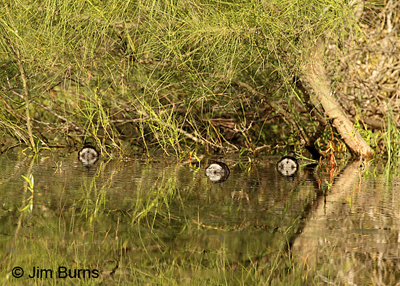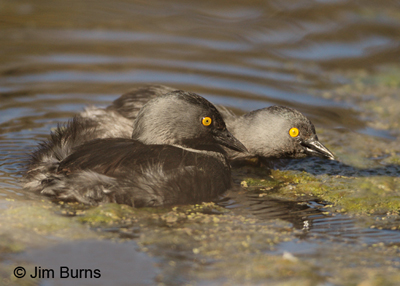
If you check it out more closely, though, or if I had blown the image up bigger, you might see something is amiss in your original assessment of the scene. Compare the size of the barrels to that of the vegetation and trees and you’ll realize these must be awfully small barrels. And they all seem to have an attachment on the front end. No, those are not spigots, and this is not a column about environmental degradation. Those three “barrels” are Least Grebes, you’re looking at their fluffed out butt feathers, and this is another column about the amazing adaptations that have evolved among avian species.
I’ve observed Least Grebes multiple times in both Texas and Arizona, and this is a typical early morning drill for this species. These little guys, only nine inches long, will line up in a row, side by side a few yards apart, facing away from the rising sun, wings closed, butts up, the white undertail coverts raised. In the morning chill on the water this is a warming mechanism which would seem counterintuitive, assuming that white feathers would not absorb as much heat from the rays of the low angle sun as dark feathers would so surely do.
The grebes’ secret however, though not generally realized, is that the bases of the white feathers are black and the underlying skin on their flanks and back contains black pigment, all perfect for absorbing the warming radiation of the rising sun. If you watch the scene for awhile, as the day warms you’ll notice the grebes’ line-up becomes less frequent and lasts shorter. In the heat of the afternoon, or on cloudy days, or in preparation for diving, the feathers are lowered. Research has also shown that even on windy days the grebes will face away from the sun rather than face into the wind as many species do. The wind may, in fact, be of benefit in this scenario, helping to raise the feathers and more fully expose the dark absorptive areas.
Least Grebes are permanent residents of south Texas where they are found both in permanent bodies of water and in impoundments that are dry for much of the year. Here in Arizona they have appeared and nested only sporadically, then apparently retreated southward into Mexico for several breeding cycles. It will be interesting to see, as global warming progresses, whether Least Grebes become permanently part of Arizona’s breeding avifauna. It would certainly seem that their adaptive strategy for thermoregulation, which researchers actually call “sunbathing,” would allow them to withstand winters in several of southern Arizona’s permanent lakes and reservoirs.